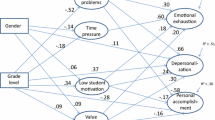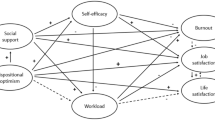Abstract
Research was conducted on the relationship between school and classroom psychosocial environment and perceptions of burnout in teachers who staff Queensland private schools. A sample of 246 teachers responded to scales that assess seven school environment and seven classroom environment dimensions and the three facets of burnout measured by the Maslach Burnout Inventory: emotional exhaustion, depersonalisation and personal accomplishment. Preliminary multiple regression analyses resulted in an hypothesised model of seven environment dimensions predicting burnout. This model was tested in a LISREL analysis with posthoc modifications improving model fit to data. While staff affiliation and work pressure were significant predictors of emotional exhaustion, staff mission consensus and co-operation in classrooms were significant predictors of depersonalisation. Staff mission consensus, together with classroom interactions, co-operation and task orientation were significantly related to personal accomplishment. Results supported previous research on the structure of teacher burnout in that emotional exhaustion influenced depersonalisation which subsequently impacted on personal accomplishment.
Similar content being viewed by others
References
Adams, J. & Adams, A. (2000, April). Development of an instrument to evaluate school-level environments in the special sector: The Special School-Level Environment Questionnaire. Paper presented at the Annual Meeting of the American Educational Research Association, New Orleans.
Aldridge, J.M. & Fraser, B.J. (2000). A cross-cultural study of classroom learning environments in Australia and Taiwan. Learning Environments Research, 3, 101–134.
Anderson, M.B. & Iwanicki, E.F. (1984). Teacher motivation and its relationship to burnout. Educational Administration Quarterly, 20, 109–132.
Bacharach, S.B., Bauer, S.C., & Conley, S. (1986). Organizational analysis of stress: The case of elementary and secondary schools. Work and Occupations, 13, 7-32.
Ball, J., Moselle, K., & Fraser, B.J. (1995, April). A study of school climate and teacher burnout. Paper presented at the Annual Meeting of the American Educational Research Association, San Francisco.
Balson, M. (1992). Understanding classroom behaviour (3rd edn). Melbourne: ACER.
Borg, M.G. (1990). Occupational stress in British educational settings: A review. Educational Psychology, 10, 102–126.
Borg, M.G., Riding, R.J., & Falzon, J.M. (1991). Stress in teaching: A study of occupational stress and its determinants, job satisfaction and career commitment among primary school teachers. Educational Psychology, 11, 59-75.
Boyle, G.J., Borg, M.G., Falzon, J.M., & Baglioni, A.J. (1995). A structural model of the dimensions of teacher stress. British Journal of Educational Psychology, 65, 49–67.
Bransgrove, E. (1994). A decade of teacher stress: The changing nature of the determinants of teacher stress, 1981 to 1991. South Pacific Journal of Teacher Education, 22, 39-52.
Brouwers, A. & Tomic, W. (2000). A longitudinal study of teacher burnout and perceived self-efficacy in classroom management. Teaching and Teacher Education, 16, 239–253.
Brouwers, A., Evers, W.J.G., & Tomic, W. (1999). Teacher burnout and self-efficacy in eliciting social support. The Netherlands: Open University. (ERIC Document Reproduction Service No. ED437342.)
Byrne, B.M. (1991). Burnout: Investigating the impact of background variables for elementary, intermediate, secondary, and university educators. Teaching and Teacher Education, 7, 197–209.
Byrne, B.M. (1994). Burnout: Testing for the validity, replication, and invariance of causal structure across elementary, intermediate, and secondary teachers. American Educational Research Journal, 31, 645–673.
Byrne, B.M. (1998). Structural equation modeling with LISREL, PRELIS, and SIMPLIS: Basic concepts, applications and programming. Mahwah, NJ: Lawrence Erlbaum.
Dorman, J.P. (1999). The evolution, validation and use of a personal form of the Catholic School Classroom Environment Questionnaire. Catholic Education, 3, 141–157.
Dorman, J.P., Adams, J.E., & Ferguson, J.M. (2002). Psychosocial environment and student self-handicapping in secondary school mathematics classes: A cross-national study. Educational Psychology, 22, 499–511.
Dorman, J.P., Fraser, B.J., & McRobbie, C.J. (1997). Relationship between school-level and classroom-level environment in secondary schools. Journal of Educational Administration, 35, 74–91.
Dorman, J.P., McRobbie, C.J., & Foster, W.J. (2002). Associations between psychosocial environment in religious education classes and students' attitude to Christianity. Religious Education, 97, 23–42.
Farber, B. (1999). Inconsequentiality-The key to understanding teacher burnout. In R. Vandenburghe & A.M. Huberman (Eds.), Understanding and preventing teacher stress: A sourcebook of international research and practice. Cambridge, UK: Cambridge University Press; pp. 159–165.
Fraser, B.J. (1994). Research on classroom and school climate. In D. Gabel (Ed.), Handbook of research on science teaching and learning. New York: Macmillan; pp. 493–541.
Fraser, B.J. (1998a). Classroom environment instruments: Development, validity, and applications. Learning Environments Research, 1, 7–33.
Fraser, B.J. (1998b). Science learning environments: Assessments, effects and determinants. In B.J. Fraser & K.G. Tobin (Eds.), International handbook of science education. Dordrecht, The Netherlands: Kluwer; pp. 527–564.
Freudenberger, H.J. (1974). Staff burnout. Journal of Social Issues, 30, 159–165.
Goh, S.C. & Fraser, B.J. (1998). Teacher interpersonal behaviour, classroom environment and student outcomes in primary mathematics in Singapore. Learning Environments Research, 1, 199–229.
Guglielmi, R.S. & Tatrow, K. (1998). Occupational stress, burnout, and health in teachers: A methodological and theoretical analysis. Review of Educational Research, 68, 61–99.
Hart, P.M., Wearing, A.J., & Conn, M. (1995). Conventional wisdom is a poor predictor of the relationship between discipline policy, student misbehaviour and teacher stress. British Journal of Educational Psychology, 65, 27–48.
Hock, R.R. (1988). Professional burnout among public school teachers. Public Personnel Management, 17, 167–189.
Holland, R.P. (1982). Special educator burnout. Educational Horizons, 60, 58–64.
Holmes-Smith, P. & Rowe, K.J. (1994, January). The development and use of congeneric measurement models in school effectiveness research: Improving the reliability and validity of composite and latent variables for fitting multilevel and structural equation models. Paper presented at the International Congress for School Effectiveness and Improvement, Melbourne.
Jackson, S.E., Schwab, R.L., & Schuler, R.S. (1986). Toward an understanding of the burnout phenomenon. Journal of Applied Psychology, 71, 630-640.
Jöreskog, K.G. & Sörbom, D. (1989). LISREL 7: A guide to the program and its applications (2nd edn). Chicago, IL: SPSS Inc.
Jöreskog, K.G. & Sörbom, D. (1993). LISREL 8: User's reference guide. Chicago, IL: Scientific Software International.
Kelloway, E.K. (1998). Using LISREL for structural equation modeling: A researcher's guide. Thousand Oaks, CA: Sage.
Lamude, K.G., Scudder, J., & Furno-Lamude, D. (1992). The relationship of student resistance strategies in the classroom to teacher burnout and teacher type-A behavior. Journal of Social Behavior and Personality, 7, 597–610.
Lens, W. & Jesus, S.N.D. (1999). A psychosocial interpretation of teacher stress and burnout. In R. Vandenburghe & A.M. Huberman (Eds.), Understanding and preventing teacher stress: A sourcebook of international research and practice. Cambridge, UK: Cambridge University Press; pp. 192–202.
Lewis, R. (1991). The discipline dilemma. Melbourne: ACER.
Malik, J.L., Mueller, R.O., & Meinke, D.L. (1991). The effects of teaching experience and grade level taught on teacher stress: A LISREL analysis. Teaching and Teacher Education, 7, 57–62.
Maslach, C. (1999). Progress in understanding teacher burnout. In R. Vandenburghe & A.M. Huberman (Eds.), Understanding and preventing teacher stress: A sourcebook of international research and practice. Cambridge, UK: Cambridge University Press; pp. 211–222.
Maslach, C. & Jackson, S.E. (1981). The measurement of experienced burnout. Journal of Occupational Behaviour, 2, 99–113.
Maslach, C. & Leiter, M.P. (1999). Teacher burnout: A research agenda. In R. Vandenburghe & A.M. Huberman (Eds.), Understanding and preventing teacher stress: A sourcebook of international research and practice. Cambridge, UK: Cambridge University Press; pp. 295–314.
Maslach, C., Jackson, S.E., & Leiter, M. (1996). The Maslach burnout inventory (3rd edn). Palo Alto: Consulting Psychologists Press.
McCormick, J. (1997). Occupational stress of teachers: Biographical differences in a large school system. Journal of Educational Administration, 35, 18–38.
Moos, R.H. (1974). The social climate scales: An overview. Palo Alto, CA: Consulting Psychologists Press.
Munck, I.M.E. (1979). Model building in comparative education: Applications of the LISREL method to cross-national survey data. Stockholm: Almqvist & Wiksell.
O'Connor, P.R. & Clarke, V.A. (1990). Determinants of teacher stress. Australian Journal of Education, 34, 41–51.
Otto, R. (1986). Teacher under stress. Melbourne: Hill.
Pettegrew, L.S. & Wolf, G.E. (1982). Validating measures of teacher stress. American Educational Research Journal, 19, 373–396.
Punch, K.F. & Tuetteman, E. (1996). Reducing teacher stress: The effects of support in the work environment. Research in Education, 56, 63–72.
Schumacker, R.E. & Lomax, R.G. (1996). A beginner's guide to structural equation modeling. Mahwah, NJ: Erlbaum.
Seidman, S. & Zager, J. (1986). The teacher burnout scale. Educational Research Quarterly, 11, 26–33.
Soerjaningsih, W., Fraser, B.J., & Aldridge, J.M. (2001, April). Achievement, satisfaction and learning environment among Indonesian computing students at the university level. Paper presented at the Annual Meeting of the American Educational Research Association, Seattle, WA.
Tatar, M. & Yahav, V. (1999). Secondary school pupils' perceptions of burnout among teachers. British Journal of Educational Psychology, 69, 457–468.
Taylor, P.C., Fraser, B.J., & Fisher, D.L. (1997). Monitoring constructivist classroom learning environments. International Journal of Educational Research, 27, 293–302.
Walberg, H.J. (1976). Psychology of learning environments: Behavioral, structural, or perceptual? Review of Research in Education, 4, 142–178.
Walberg, H.J. & Anderson, G.J. (1968). Classroom climate and individual learning. Journal of Educational Psychology, 59, 414–419.
Waldrip, B.G. & Fisher, D.L. (2001, April). Associations between teacher-student interactions, student attitudes and teachers' confidence in primary science. Paper presented at the Annual Meeting of the American Educational Research Association, Seattle, WA.
Wheldall, K., Beaman, R., & Mok, M. (1999). Does the individualized classroom environment questionnaire (ICEQ) measure classroom climate? Educational and Psychological Measurement, 59, 847–854.
Wubbels, T. & Levy, J. (Eds.). (1993). Do you know what you look like? Interpersonal relationships in education. London: Falmer.
Author information
Authors and Affiliations
Corresponding author
Rights and permissions
About this article
Cite this article
Dorman, J.P. Relationship Between School and Classroom Environment and Teacher Burnout: A LISREL Analysis. Social Psychology of Education 6, 107–127 (2003). https://doi.org/10.1023/A:1023296126723
Issue Date:
DOI: https://doi.org/10.1023/A:1023296126723




